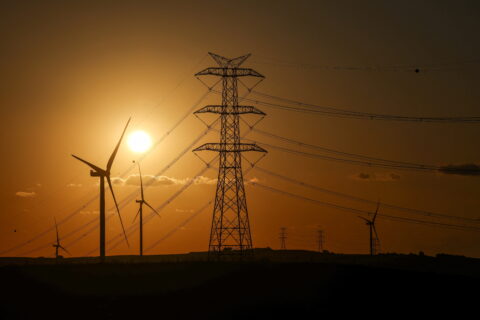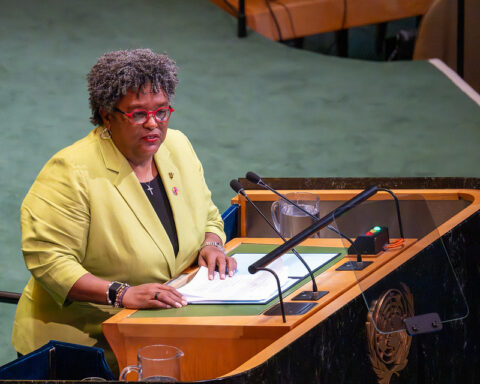Last year saw a record number of UK newspaper editorials opposing climate action – almost exclusively from right-leaning titles – new Carbon Brief analysis shows.
The analysis is based on hundreds of UK national newspaper editorials, which are the formal “voice” of the publications.
The 354 editorials published in 2023 relating to energy and climate change add to thousands more collected in a long-running project started by Carbon Brief.
Newspapers such as the Sun and the Daily Mail published 42 editorials in 2023 arguing against climate action – nearly three times more than they have printed before in a single year.
They called for delays to UK bans on the sale of fossil fuel-powered cars and boilers, as well as for more oil-and-gas production in the North Sea. In response to such demands, prime minister Rishi Sunak performed a “U-turn” in September on some of his government’s major net-zero policies.
Last year also saw a surge in hostility towards climate protesters, with editorial attacks doubling compared to recent years.
This analysis is part of a project assessing the attitudes of UK newspapers to climate change and energy since 2011. It shows that after a period of embracing climate action, right-leaning publications have largely returned to their historic stance of arguing against climate action.
- Record opposition to action
- Cost of net-zero
- Labour criticism
- Targeting climate activists
- Methodology
Record opposition to action
Carbon Brief captured 354 articles in its database of climate- and energy-related newspaper editorials last year, touching on topics ranging from UK energy bills to flooding in Libya.
Roughly half of these – 174 in total – specifically called for either more or less climate action. The main focus of these editorials was the UK government’s net-zero target and the policies it is implementing, or failing to implement, in order to achieve this goal.
As the chart below shows, the 42 editorials arguing for less action last year marked a new record for the past 13 years of climate coverage.

There was a clear partisan divide in attitudes towards climate action.
Nearly every editorial published in left-leaning and centrist titles that offered an opinion on climate action advocated for more to be taken. These made up around three-quarters of the articles calling for “more action” overall.
The Guardian, for example, published editorials calling for an end to oil exploration in the UK and for the world to get rid of fossil fuels “entirely”.
By contrast, around half of the climate-related editorials published in right-leaning titles, such as the Sun and the Daily Mail, actively opposed climate action. Only one-third of these editorials supported climate action and the remainder expressed a mix of views.
As the chart below shows, the past two years have seen a dramatic fall in the share of right-leaning newspaper editorials supporting climate action – and a rise in the share opposing it.
Prior to this downward trend, right-leaning titles with long histories of climate scepticism had been showing growing enthusiasm for climate action. The Daily Express and the Sun even launched special climate initiatives in 2021, as the UK prepared to host the COP26 summit.
The drop in support for climate action among right-leaning newspapers was followed by the government rolling back some of its climate policies in 2023. (See: Cost of net-zero.)

Carbon Brief also analysed a smaller set of 64 editorials from the 354 published in 2023 that discussed notable energy sources – specifically, renewables, nuclear power and fracking for shale gas.
Within this group, there were 14 editorials that were explicitly anti-renewable energy.
This is the highest number since 2013, when there was widespread opposition to wind energy within the right-leaning press.
Some of the criticism last year was reminiscent of that era. The Sun, for example, said solar and wind generation “will never reliably power a country this size and with such variable weather”.
(While other low-carbon energy sources would be needed, the Climate Change Committee has concluded that the UK could achieve a reliable decarbonised power system by 2035 in which wind and solar meet 70% of demand.)
A Sunday Telegraph editorial said that “supposed progress” in renewables had “only been achieved thanks to lavish subsidies”. (In fact, wind and solar remain the cheapest way to generate electricity in the UK.)
Cost of net-zero
By far the most common anti-climate action narrative in newspaper editorials last year was the economic impact of what the Sun on Sunday called “bonkers net-zero policies that will just push prices up”. (Energy prices remain elevated thanks to expensive gas.)
The cost of net-zero, especially the up-front cost of buying electric vehicles and heat pumps, was consistently framed by right-leaning newspapers as something British people, in the words of the Sun, “just cannot afford”. (These papers invariably fail to mention the costs of inaction.)
This has been a popular topic among some right-wing and climate-sceptic commentators since the net-zero target was first proposed. This is in spite of analysis indicating that a net-zero transition would, ultimately, save UK households money.
As the chart below shows, costs emerged as an even bigger talking point in 2023, with one-third of all climate-related editorials referencing the issue. There were twice as many editorials in the past year mentioning the high costs of action than there has ever been.

Many, such as the Daily Mail, cited the wider economic situation in the UK as a reason not to act on climate change:
“When net-zero was made legally binding by 2050, Britain had not had Covid, the Ukraine war and rampant inflation. Now the country is skint and can’t afford it.”
(It is worth mentioning that publications such as the Daily Mail have been making similar arguments since long before any of these issues emerged. In 2017, it stated that climate action had only come at a “crippling cost to Western economies”.)
In light of what they argued were “unaffordable” costs, these publications argued that the best course of action would be to abandon “unrealistic” net-zero policies.
(The Office for Budget Responsibility has said that the costs of failing to act on climate change would be “much larger” than the costs of taking action.)
Right-leaning publications published numerous editorials calling for the government to delay or scrap plans to phase out gas boilers and internal combustion engine cars, introduced under former Conservative prime minister Boris Johnson. One Daily Telegraph editorial said:
“There would surely be huge political benefits to scrapping all these pointlessly punitive measures.”
On 20 September, Conservative prime minister Rishi Sunak gave a speech in which he announced a series of rollbacks of net-zero policies that he said would protect “hard-working British people” from “unacceptable costs”. These included delays to the phase-out of fossil fuel-powered vehicles and boilers, as well as efficiency rules.
(Far from reducing costs, the rollbacks are expected to cost renters £2bn per year and drivers £6bn cumulatively, by leaving homes more draughty and cars more expensive to run.)
As the chart below shows, the speech followed a flurry of editorials warning of the costs of net-zero. After Sunak’s announcement, these editorials almost stopped entirely.

Left-leaning and centrist publications rejected the notion that net-zero policies would inevitably place an economic burden on people in the UK.
The Guardian noted that, while “reaching net-zero will be costly and disruptive”, this just made it vital to have a “well-thought-out plan to share the cost equitably”. The Financial Times made the case for “green growth”, stating:
“True leadership…would involve finding ways to carry voters with [Sunak] through the challenges ahead and seizing on the green transition to rekindle growth and spur innovation.”
Labour criticism
Sunak’s net-zero rollback was widely perceived by the UK press as an attempt to put “clear blue water” between himself and Keir Starmer, the leader of the opposition Labour party.
Meanwhile, there was a concerted effort in the right-leaning press to discredit Labour’s two flagship climate announcements – namely, pledges to spend £28bn each year on “green” investment and to stop issuing new oil-and-gas licences.
This was particularly evident in the Sun and the Daily Mail, the UK’s two most widely read national newspapers. Of the 128 climate- or energy-related editorials from these newspapers captured in Carbon Brief’s database last year, 31 took aim at Labour’s climate proposals.

The debate around North Sea oil and gas was a major talking point last year, with many right-leaning editorials stating that new drilling licences would be vital for the UK’s energy security. (After a surge of interest in 2022, fracking was virtually forgotten last year, with just two editorials mentioning it in 2023.)
Labour officially announced in May that it planned to stop all new oil-and-gas developments.
Right-leaning newspapers responded by implying that environmental activist group Just Stop Oil and low-carbon energy tycoon Dale Vince were responsible for setting Labour’s policies. This claim was based on the fact that Vince, who had financially supported Just Stop Oil, had also given £1.5m to Labour.
In total, there were 16 editorials in the Sun, the Sun on Sunday and the Daily Mail about Vince’s support for Just Stop Oil and Labour. They described Vince as “bankrolling” Labour and helping to “dictate its green agenda”, framing Labour as “allies” of Just Stop Oil and “in their pocket”.
(Vince’s £1.5m in donations to Labour were spread over 10 years. The Labour Party has received donations totalling nearly £30m in the most recent 12 months for which official data is reported. The Conservatives have received £43m over the same period.)
These narratives were later picked up by then net-zero secretary Grant Shapps, who wrote a letter to Starmer in July concerning Vince’s support, and called Labour the “political wing of Just Stop Oil”.
(Responding to criticism, Starmer said in August that Labour would honour existing North Sea licences and maintain oil-and-gas fields “for decades to come”. He called Just Stop Oil’s more radical demands “contemptible”. Vince announced in October he would stop funding Just Stop Oil.)
More broadly, there was also an effort to frame Labour’s “green” policies as what the Sun called a “turn-off for much of the electorate”. This was particularly true following the Uxbridge by-election in July, where the Labour London mayor Sadiq Khan’s anti-air pollution policy, the ultra-low emissions zone (ULEZ), was viewed as significant in Labour narrowly missing out on winning the seat.
There were also many editorials throughout 2023 attacking shadow net-zero secretary Ed Miliband, with the Sun stating:
“Labour wanted to gamble a monstrous £28bn a year in borrowed money on a ‘green industrial revolution’ dreamed up by Ed Miliband, a man voters rejected in 2015 as incompetent.”
The media continues to fuel speculation over Labour’s £28bn “green prosperity plan”, which Starmer recently defended.
Targeting climate activists
Climate activists have been a major target for right-leaning newspapers in recent years, especially since Extinction Rebellion’s mass protests in 2019.
Yet their hostility towards climate activists reached new levels last year. There were 56 editorials taking aim at these groups, with 43 of these targeting Just Stop Oil. As the chart below shows, this is more than double the previous record of 25, set in 2022.
Editorials in the Sun and the Daily Mail described Just Stop Oil as a “criminal cult”, “eco-loons” and “deranged”. The Sun devoted entire editorials to targeting individual activists for taking flights or driving a car to the supermarket to buy fruit.

In a year that saw the government introduce strict and controversial new legislation to crack down on protests, UK newspapers were vocal in their support for tougher treatment of climate activists.
Prior to new penalties being introduced under the Public Order Act, a Times editorial about Just Stop Oil protests stated that “the law is as asinine as the tactics of those narcissists”.
The Sun, meanwhile, said the police were “too busy with fashionable woke causes and politely escorting Just Stop Oil protesters to bother with catching crooks”.
Methodology
This is a 2023 update of previous analysis conducted for the period 2011-2021 by Carbon Brief in association with Sylvia Hayes, a PhD researcher at the University of Exeter. The 2022 update can be found here.
The full methodology can be found in the original article, including the coding schema used to assess the language and themes used in editorials concerning climate change and energy technologies.
The analysis is based on Carbon Brief’s editorial database, which is regularly updated with leading articles from the UK’s major newspapers.
The post Analysis: Record opposition to climate action by UK’s right-leaning newspapers in 2023 appeared first on Carbon Brief.
Analysis: Record opposition to climate action by UK’s right-leaning newspapers in 2023
Climate Change
IEA: Renewables have cut fossil-fuel imports for more than 100 countries
More than 100 countries have cut their dependence on fossil-fuel imports and saved hundreds of billions of dollars by continuing to invest in renewables, according to the International Energy Agency (IEA).
It says nations such as the UK, Germany and Chile have reduced their need for imported coal and gas by around a third since 2010, mainly by building wind and solar power.
Denmark has cut its reliance on fossil-fuel imports by nearly half over the same period.
Renewable expansion allowed these nations to collectively avoid importing 700m tonnes of coal and 400bn cubic metres of gas in 2023, equivalent to around 10% of global consumption.
In doing so, the fuel-importing countries saved more than $1.3tn between 2010 and 2023 that would otherwise have been spent on fossil fuels from overseas.
Reduced reliance
The IEA’s Renewables 2025 report quantifies the benefits of renewable-energy deployment for electricity systems in fossil fuel-importing nations.
It compares recent trends in renewable expansion to an alternative “low renewable-energy source” scenario, in which this growth did not take place.
In this counterfactual, fuel-importing countries stopped building wind, solar and other non-hydropower renewable-energy projects after 2010.
In reality, the world added around 2,500 gigawatts (GW) of such projects between 2010 and 2023, according to the IEA, more than the combined electricity generating capacity of the EU and US in 2023, from all sources. Roughly 80% of this new renewable capacity was built in nations that rely on coal and gas imports to generate electricity.
The chart below shows how 31 of these countries have substantially cut their dependence on imported fossil fuels over the 13-year period, as a result of expanding their wind, solar and other renewable energy supplies. All of these countries are net importers of coal and gas.

In total, the IEA identified 107 countries that had reduced their dependence on fossil fuel imports for electricity generation, to some extent due to the deployment of renewables other than hydropower.
Of these, 38 had cut their reliance on electricity from imported coal and gas by more than 10 percentage points and eight had seen that share drop by more than 30 percentage points.
Security and resilience
The IEA stresses that renewables “inherently strengthen energy supply security”, because they generate electricity domestically, while also “improving…economic resilience” in fossil-fuel importer countries.
This is particularly true for countries with low or dwindling domestic energy resources.
The agency cites the energy crisis exacerbated by Russia’s invasion of Ukraine, which exposed EU importers to spiralling fossil-fuel prices.
Bulgaria, Romania and Finland – which have historically depended on Russian gas for electricity generation – have all brought their import reliance close to zero in recent years by building renewables.
In the UK, where there has been mounting opposition to renewables from right-wing political parties, the IEA says reliance on electricity generated with imported fossil fuels has dropped from 45% to under 25% in a decade, thanks primarily to the growth of wind and solar power.
Without these technologies, the UK would now be needing to import fossil fuels to supply nearly 60% of its electricity, the IEA says.
Other major economies, notably China and the EU, would also have had to rely on a growing share of coal and gas from overseas, if they had not expanded renewables.
As well as increasing the need for fossil-fuel imports from other countries, switching renewables for fossil fuels would require significantly higher energy usage “due to [fossil fuels’] lower conversion efficiencies”, the IEA notes. Each gigawatt-hour (GWh) of renewable power produced has avoided the need for 2-3GWh of fossil fuels, it explains.
Finally, the IEA points out that spending on renewables rather than imported fossil fuels keeps more investment in domestic economies and supports local jobs.
The post IEA: Renewables have cut fossil-fuel imports for more than 100 countries appeared first on Carbon Brief.
IEA: Renewables have cut fossil-fuel imports for more than 100 countries
Climate Change
Panama environment minister backs calls for reform of UN climate process
Panama’s environment minister has joined a growing push for reform of the UN climate change negotiations, proposed by campaigners and academics in recent years – one of the first such calls by a minister directly involved in the talks.
Juan Carlos Navarro told Climate Home in a recent interview on the sidelines of Climate Week in New York that the current system for approving decisions – which requires all countries to agree by consensus – has not delivered good enough results and should instead use a majority or super-majority decision-making process.
“By consensus, you cannot get 186 nations to agree on anything. It’s a miracle we have come so far,” said Navarro. “We need to change the rules so we have a basic, rational, majority or super-majority decision-making process where we can do things better and faster.”
The comments follow pressure from civil society and academics to reform the UN climate process. In June, more than 200 campaign groups issued a joint call to reform the decision-making process, which they argued can be blocked by oil and gas-producing countries and has reached a “breaking point”.
Andreas Sieber, policy director with climate advocacy group 350.org, said he was sympathetic to Panama’s proposal, but added “it would just be part of a puzzle” to make the UN climate talks work more efficiently.
He added that it could be hard to get over the line as earlier efforts to secure a rule on voting as a last resort had met with fierce opposition from oil-producing countries – and decisions reached by consensus have the weight of having all the countries behind them, he noted.
Erika Lennon, Senior Attorney at the Center for International Environmental Law, celebrated that more people are talking about potential changes to the UNFCCC, as “being totally beholden to consensus-based decision making is not leading to the outcomes that we need”.
She also agreed that voting is just part of the solution, and suggested possible reforms could include increased transparency in the negotiation rooms, inclusion of civil society and indigenous groups, and a conflict of interest rule that blocks fossil fuel companies from participating.
During last year’s COP29 in Baku, a group of experts known as the Club of Rome – among them the former UN climate chief Christiana Figueres and former UN Secretary-General Ban Ki Moon – issued an open letter proposing ways to modernise the climate process.
The current structure of COPs “simply cannot deliver the change at exponential speed and scale, which is essential to ensure a safe climate landing for humanity”, the letter said. They argued instead for “smaller, more frequent, solution-driven meetings” where countries can discuss progress and be held accountable.
At that same COP in Azerbaijan, Saudi Arabia managed to block all mentions of fossil fuels in text summarising discussions on cutting greenhouse gas emissions. It was able to do this despite all countries having agreed to transition away from fossil fuels in energy systems just one year earlier at COP28.
UN Climate Change consults on COP process
In a speech at Climate Week in New York, Simon Stiell, the executive secretary of UN Climate Change, noted that recent COPs have delivered “concrete results and global steps forward”, adding that cooperation under the process has lowered expected global warming from 5C to closer to 3C.
But, he conceded, it is “imperfect”. “As this new era of implementation gathers pace, we must also keep evolving, and striving towards faster, fully-inclusive, higher-quality decisions that tie the formal process ever-closer to real economies and real lives,” he said.
Senior experts have been asked to examine how the UN climate process could be improved and will deliver their ideas to Stiell later this year. The secretariat will consult with countries on any potential reforms it wants to pursue in 2026, the UN’s climate chief added.
Brazil, the host country of this year’s COP, has put the focus on global mobilisation to implement in practice what governments signed up to in the 2015 Paris Agreement. Last year it proposed setting up a UN Climate Change Council in order to support that work, but this proposal does not seem to have gained much traction amid geopolitical tensions and Trump’s attacks on multilateral climate action.

Downsizing COPs?
Panama’s Navarro added that the UN climate summit has grown too big, making its scope “ridiculous”. In 2023, over 83,000 people attended COP28 in Dubai, while COP29 in Baku saw fewer, with 66,778 registered participants.
Navarro said the COP meetings had become an anachronism. “You have thousands and thousands of people who are living off the story,” he said. “They’re living off these meetings, just sitting around the world on expense accounts, creating a bigger carbon footprint for the planet, and we’re not achieving anything.”
In April 2024, UNFCCC head Stiell said personally he “would certainly like to see future COPs reduce in size”, telling an audience at London’s Chatham House think-tank that “bigger doesn’t necessarily mean better”.
This year, COP30 will be held in the Amazon city of Belem, which poses “self-evident” financial and logistical limitations, according to Navarro, who praised Brazil for being open to hearing the complaints from the Global South countries on this topic.
After many delegations complained over the high costs of accommodation and difficult access, Brazil offered cruise-ship rooms and price caps, and the UN has increased the daily subsidy for diplomats from most developing nations to attend the summit.
Landmark ICJ climate ruling must be turned into concrete action on shipping
‘Less hypocrisy, more concrete results’
“Having said that, and coming back to the point of what COPs have become, I wish that COPs were less bullshit, more concrete results,” Navarro told Climate Home.
His own country – which is judged to be carbon-negative, thanks to its extensive carbon-storing forests – recently published its “Nature Pledge”, combining climate, biodiversity and conservation pledges. Those include restoring 100,000 hectares of ecosystems such as degraded mangroves by 2035, maintaining 30% of Panama’s land and seas under protection and absorbing 5 million tons of CO₂.
Practical measures to achieve that include new equipment for park rangers, more radars to monitor and catch illegal fishing, and fines for polluting industries.
Panama has also set up a Nature Fund, which aims to collect $150 million-$200 million for conservation projects using resources like blue carbon bonds, debt-for-nature swaps and a national carbon market backed by blockchain with revenues going to the public sector to ensure “transparency and accountability”.
Without specifying which, Navarro called out “countries that do an incredible job of greenwashing, talking about conservation and talking about the environment – and they’re either oil producers or plastics producers, or kill whales or are destroying our fisheries, or keep building coal power plants or keep polluting”.
“We’ve run out of time for all of these hypocritical individuals, corporations – or even nations,” he added.
The post Panama environment minister backs calls for reform of UN climate process appeared first on Climate Home News.
Panama environment minister backs calls for reform of UN climate process
Climate Change
AI and satellite data help researchers map world’s transition minerals rush
Researchers are using satellite images and AI-powered modelling to map global mining activity, seeking to plug gaps in existing data as the rush for “transition minerals” fuels concerns about the industry’s impact on the environment and local communities.
Countries are scrambling to shore up supplies of metals vital for the transition to renewables, such as lithium used in electric vehicle (EV) batteries, and copper – used in solar panels and wind turbines, many of which are produced in environmentally sensitive areas.
“New mines will likely be in areas of high biodiversity, or where water and Indigenous rights are at stake,” project lead Victor Maus from the Vienna University of Economics and Business told Climate Home News.
More than half of energy transition mineral resources are located on or near the lands of Indigenous peoples and subsistence farmers, according to a 2022 study published in the Nature journal.
“Monitoring those impacts is critical,” said Maus, whose team members have identified massive gaps in current data when it comes to what, how and even where minerals are being extracted around the world.
During a previous project, they compared global satellite imagery of 120,000 square kilometres of visible mine footprints with the S&P Capital IQ Pro database of mining production. The results were stark. More than half of the mining areas identified from space had no corresponding production data in the official record.
To address these gaps, Maus and his team are building a mining database using satellite images. The project, which is part of the European Union-funded Mine the Gap initiative, will be a vital tool for policymakers and help foster transparency in the mining industry, he added.
“We’re hoping to create not only a research tool but also a means of validating and complementing what companies report, supporting greater transparency across the sector.”
Mapping environmental impact
As well as counting mines and assessing overall production, the database will give a clearer picture about where the biggest environmental and social risks lie by tracking land use around mines, waste generation and signs of environmental degradation.
“Simply knowing how much is being produced isn’t a direct measurement of impact,” said Tim Werner, a senior lecturer at The University of Melbourne who has worked with Maus on previous research into critical minerals.
“We simply don’t have all the information we need to scientifically prove where impacts for one area are worse than others. This is a big problem for strategic environmental management at national and global scales,” he added, describing the data gaps as “mind-boggling”.
A range of satellites are being used to collect the required information, including multispectral imagery, radar and hyperspectral sensors, collected from sources including the EU’s Sentinel constellation and German DLR satellites, chosen for their global coverage and accuracy.
AI will then be used to scan these images, learning how to identify and track potential issues as the project develops.
The challenges of collecting mining data
There have been previous attempts to map the overlap between energy transition mineral mines and key biodiversity hotspots in different mineral-rich countries, as well as industry efforts to plug the gaps in data about global mining production.
But past efforts to map global mining more accurately have struggled to document small-scale and artisanal mining operations, which are often unregulated despite their significant social and environmental impacts.
In September, the International Council on Mining and Metals (ICMM) launched its global mining database – reportedly the most comprehensive mining resource to date, with information about more than 15,000 active facilities in 151 countries, but it does not include informal mining sites.
“We had to draw some scope boundaries,” said Emma Gagen, the ICMM’s data and research director. “The industry is huge and that’s been the challenge this whole time – people haven’t tried to collect this data before because it’s so vast.”
The case for clearer global standards
Despite such data initiatives, which reflect growing pressure on the industry to clean up its act, researchers say structural and legislative changes will be needed to reduce the harms caused by mining.
Gagen said more uniform regulatory standards would “drive performance improvements across the industry.”
“What’s most needed is alignment,” Maus said. “Clearer global standards on what should be measured and reported, and policies that encourage disclosure of mining data.”
For Maus and his team, having an accurate picture is a crucial first step.
“If we don’t even know how many materials are being produced, we’ve got very little basis to even understand the scale of possible impacts in an area,” Werner said.
Main image: Satellite image showing the expansion of nickel mining in Sulawesi, Indonesia (Photo: Sentinel-2 cloudless by EOX IT Services GmbH, which contains modified Copernicus Sentinel data 2024)
The post AI and satellite data help researchers map world’s transition minerals rush appeared first on Climate Home News.
AI and satellite data help researchers map world’s transition minerals rush
-
Climate Change2 years ago
Spanish-language misinformation on renewable energy spreads online, report shows
-
Climate Change2 months ago
Guest post: Why China is still building new coal – and when it might stop
-
Climate Change Videos2 years ago
The toxic gas flares fuelling Nigeria’s climate change – BBC News
-

 Greenhouse Gases1 year ago
Greenhouse Gases1 year ago嘉宾来稿:满足中国增长的用电需求 光伏加储能“比新建煤电更实惠”
-

 Climate Change1 year ago
Climate Change1 year ago嘉宾来稿:满足中国增长的用电需求 光伏加储能“比新建煤电更实惠”
-
Greenhouse Gases2 months ago
Guest post: Why China is still building new coal – and when it might stop
-

 Carbon Footprint2 years ago
Carbon Footprint2 years agoUS SEC’s Climate Disclosure Rules Spur Renewed Interest in Carbon Credits
-
Renewable Energy3 months ago
US Grid Strain, Possible Allete Sale



















